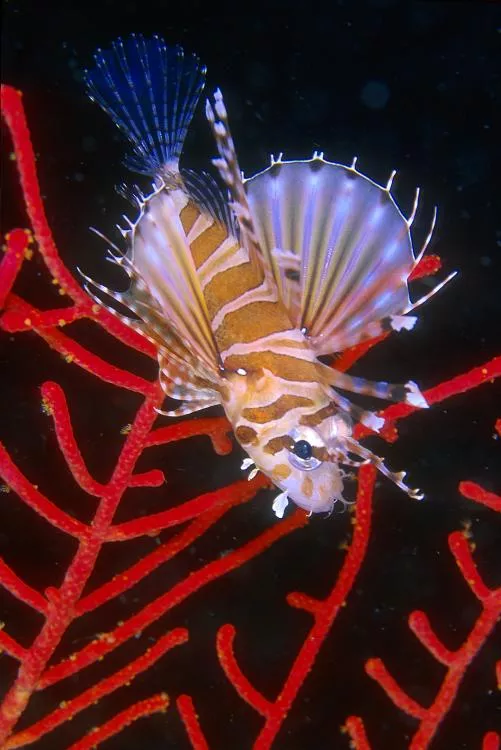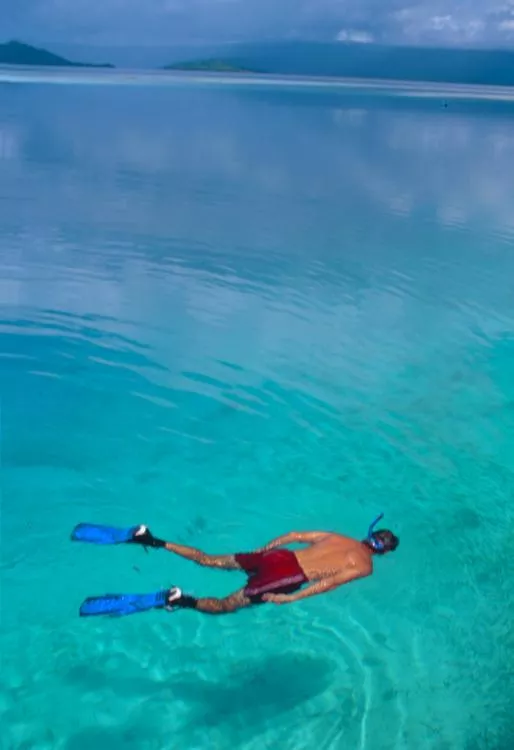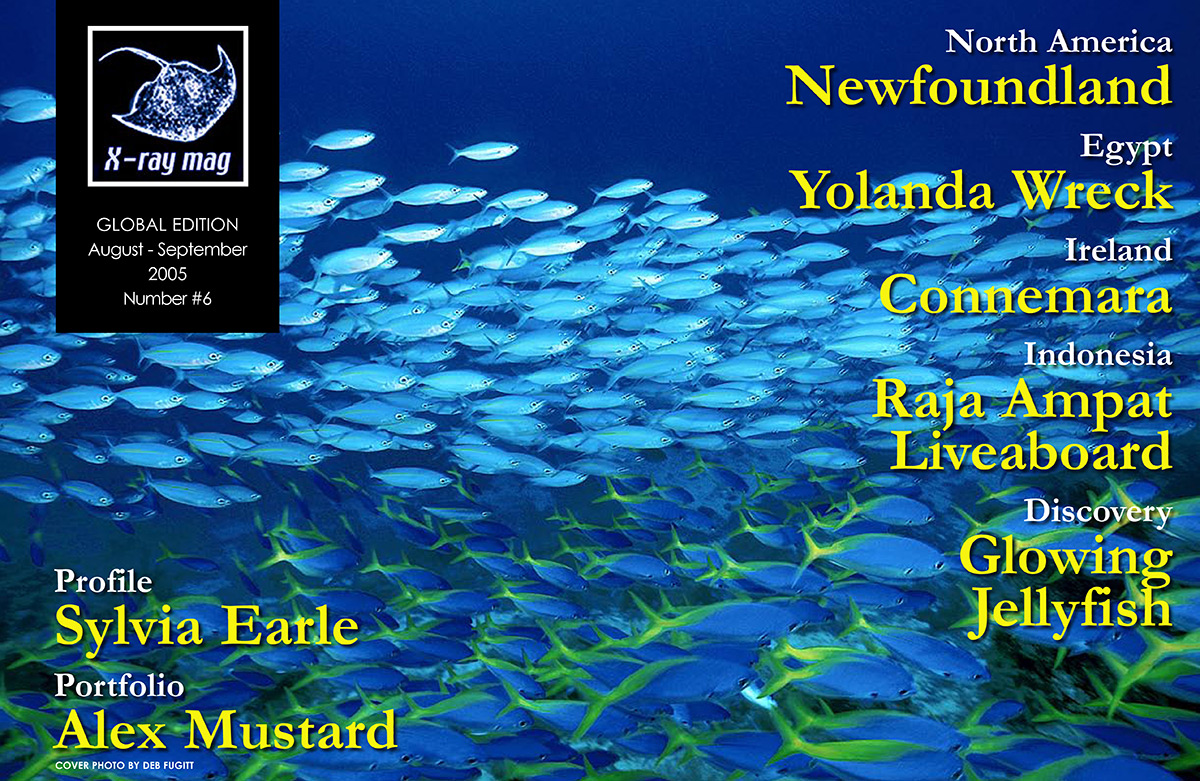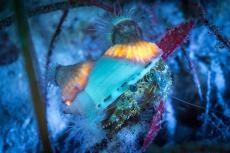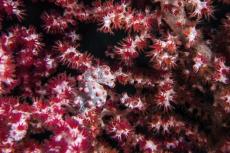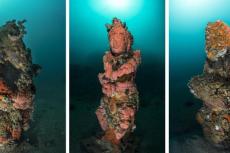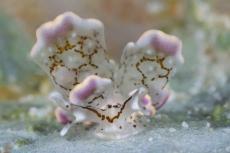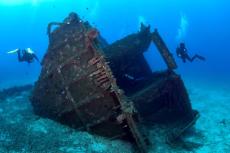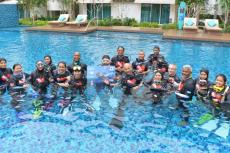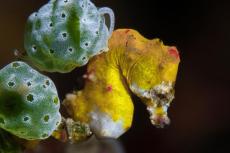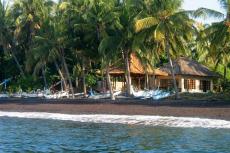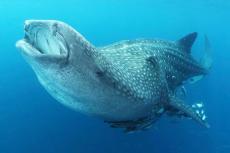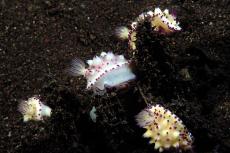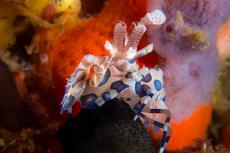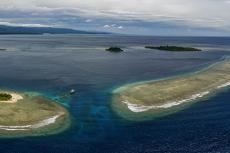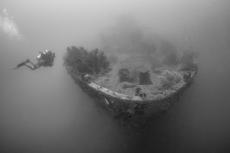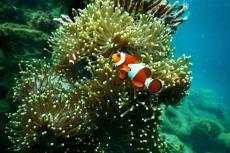Raja Ampat in Indonesia is dotted with tiny islands scattered like beads across an area of sea and surrounded by large platform and fringing reef systems.
Contributed by
The seas here are calm much of the year due to light winds and the shelter provided by nearby islands and reefs. Everywhere one looks, potential dive sites beg to be explored and with a water temperature always in the 27-28° C range we would be happy to spend many hours per day doing so.
Strong currents are very common on reefs throughout the area. This is a good thing as the current diving provides us with colourful soft corals and packs the huge schools of fish into dense masses. The currents also bring nutrients for the small creatures. Raja Ampat is becoming well known for its diverse marine life by scientists and divers alike.
As a still photographer, Raja Ampat appeals to me for its wide angle opportunities, video being the only better tool to capture the area’s wonders. Nowhere else I’ve dived offers such consistent mind-boggling vistas of fish and corals. Yet, focusing down to a smaller level there are macro creatures galore.
Areas of mushroom-shaped rock islands seem to harbour some of the better dive sites and make for beautiful and interesting topside scenery as well. This area is destined to become a World Heritage Site.
Dr Gerald Allen declared recently that “Raja Ampat represents the bulls-eye of biodiversity in coral reefs” and recommended, “we protect the reef at all costs because it represents the baseline to which all other reefs in the world be compared.”
Raja Ampat is considered remote. Located off the Northwest “Bird’s Head” Peninsula of New Guinea Island, Raja Ampat is a cluster of over 1500 small islands, bays and shoals surrounding the four islands of Misool, Salawati, Batanta and Waigeo. Named after the “Four Kings” of these islands, Raja Ampat is a part of the West Papua province of Indonesia which was formerly Irian Jaya and is now its own district with its own government.
“Remote” depends on your definition. While much of the area is unexplored, it is easy enough to fly by jet into the local Sorong airport from Manado or Makassar (Ujung Pandang) where you are collected by ship to travel an hour or so to the diving areas.
Bear hugs and big fish
“Michael!” We cried out in unison as we hopped aboard SMY Ondina, our liveaboard home for the next month. Stepping agilely across the deck, sidestepping bewildered-looking new passengers, crew and luggage, Michael reached my companion, Tony, quickly.
Wrapping his powerful arms around Tony’s waist, Michael hoisted Tony in a giant bear hug spinning him effortlessly in a circle while carrying him across the deck. A joyous reunion with an old friend portended great adventures for our first liveaboard charter in the Raja Empat islands.
When Tony Matheis and I began coming to Raja Ampat in ’99, it was Michael who, after two weeks of so-so diving with other guides, put us into the water in the conditions that we now recognize as optimal for seeing the reefs and fish life at their finest. Opting for diving with him from a longboat instead of with the other tourists on the dive boat was the best decision I had made in years.
Michael has an uncanny ability to know the conditions underwater, where the fish are schooling and the direction and force of the current, all necessary skills to get the most out of a dive in the current-swept areas of the enormous reef systems in this hot new dive destination. Thanks to his years of experience in the area, we came home with some of the best images in years.
Our guide dropped us into immense schools of Pale or Blue Tail Surgeonfish. As we plunged headfirst toward the bottom we scattered huge schools of bannerfish and streams of fusiliers so as to get in front of the reef before the current carried us over the top. The surgeonfishes hanging effortlessly in the current were so densely packed, they were like black and blue walls stretching from the sand to the top of the reef.
When separated by less than 10 meters from my buddy, I could not see him or the flash from his powerful strobes.
Over and over, we jumped into the fishiest dives I had ever seen. Again and again, we left our secure current-less spot in front of the reef out of film but not bottom time. We soared like gliders over the tops of immense reefs surveying the life below until we slowly surfaced a hundred meters or more away from our site and were met instantly, and incredibly, by Michael, who hoisted me up with his muscular arms back onto the longboat.
The longboat is a sort of overgrown wooden canoe equipped for transporting material through the islands, not for divers. While the men with their natural upper body strength climbed easily aboard, I had to be lifted.
After the first day and multiple bruises on hip bones, I worked out a successful, if rather comical, alternative method that always put the men into fits of laughter. After handing up my fins, I would lay back in the water and throw my legs over the edge, then two of the men would grab my arms and sit me up into the boat. Hey! At least the bruises were all behind me now.
That was when we fell in love with Raja Ampat’s diving.
Ah, those were the good old days! We survived on peanut butter, bread and canned tuna and kept on coming back to dive as often as we could.
The Liveaboard Trip
For our month long trip, I chartered SMY Ondina, a traditional Phinisi ship built in Bira, South Sulawesi,
Indonesia, of exotic hardwoods. She is a Spanish-owned ship whose interior layout was designed by the on-board owner and cruise director, Ricard Buxo, who also supervised the ship’s construction. Ricard’s careful design makes Ondina function as though it is a much larger ship. Cabins are spacious, and the dive deck is well organized. There are tables, charging and camera rinse facilities for the photographers, and there is room for guests to spread out. Numbers of guests are limited, so that divers can get in more dives.
Ondina’s Captain Ambo worked in Papua for five years on a different ship and now has a total of seven years experience in the area. He is quite skilled in navigating the treacherous reefs and helps plan our flexible itinerary estimating times and possible routes when we want to make a change.
Although SMY Ondina’s crew is quite experienced, Michael and one other Papuan guide were asked to come along to help with the dive schedule, which included more dives per day than a normal trip. Michael fished these waters with his father before showing the first dive operator in the area the best reefs for fish as well as the location of many WWII wrecks. Every trip made is geared toward photographers, and entire days are often spent at one site alone diving the sites as many times as desired.
Bottom time is not arbitrarily limited. The crew is happy with our arrangement, as the guests can dive and the crew can still get a bit of rest during the day. Michael, however, is always watching the divers and somehow knows which diver is where on the reef— although I would swear he cannot see them.
Dampier Straits
First, we headed out to the Dampier Straits to dive the long, fishy reefs there. Depending on the current, dives are best at one reef or another. There are several world-class sites within a 15 minute ride. When the current is running, the best location is chosen, divers are dropped just in front of the reef and then the current carries them back into the sweet spot just in front of the boat.
In this area, we expect to see lots of fish, turtles, manta rays, schools of large bumphead parrotfish munching the corals and plenty of fish. Oh, and did I mention there are quite a lot of fish here? First Dive The red and white inflatable dive tenders ferried us out to the reef where fortunately there was a manageable current running.
Falling backwards over the side, I did a complete underwater somersault and surfaced briefly for Michael to hand in my camera. I made a quick survey from the top which showed so-so visibility but plenty of fish and diver activity.
Clouds of tiny fish surrounded some of the coral bommies while up and down the steep slopes of the site, schools of four-lined snappers, sweetlips, fusiliers and rabbitfish wandered amongst red and purple soft corals, leather and black coral bushes.
The divers from the first tender were already busy. From my vantage point, I saw several divers waiting around an overhang to photograph a frilly-edged Tasselled Wobbegong Shark, which rested underneath; others lining up shots with several intermediate batfish in front of coral covered bommies; and our trip’s anemonefish addict, Marylou, setting her sights on a beautiful green anemone that was host to a pair of brilliant red Spinecheek Anemonefish.
The current split at the point of the reef. I let myself be carried down current to check out some coral-encrusted bommies on the white sand bottom that are very colourful places to make a horizontal image. Afterwards, I stayed low, ducking behind corals and large fans, playing eddies created by the current so as to get back up to the point without an exhausting swim in open water.
Just to the other side of the point, yellow streams of four-lined snappers swarmed over the slope like yellow rivers, parting around coral islands and pausing beneath towering table corals. These docile fish allowed me to swim right into their schools, coming within inches of my camera lens. The school flexed and finally parted to let me pass.
I made a brief visit to a large soft coral covered bommie with a horizontal V-shaped crevasse underneath to see that it was, as usual, filled with several large batfish, some oriental sweetlips and a few smaller fish.
Turning back toward the point, the area most densely covered in life, I spotted a giant clam on top of the point. The spot must have been a great place for filter feeders as the clam was huge. But it was also a tough spot for a diver to stay still. I ducked down behind the bommie beside the clam and waited for schools of fish to pass over and behind the clam to catch a more interesting wide-angle scene on film.
Favourite Sites for Small Creatures
One of the favourite macro photography sites on the trip was in deep bay on the western end of Waigeo where a long wall alternates with a steep slope both covered in corals and anemones and shadowed by rainforest from the island above.
The site is populated by orang-utan crabs, ghost pipefish, a great variety of nudibranchs, several species of lionfish and of course, pygmy seahorses.
Pygmy seahorses seem to be everywhere, so we restrict ourselves to looking for them on designated macro days when we are diving in calm areas.
This site could be dived from 30 meters to the surface so bottom time was no problem. We took advantage of this by spending the entire day at this site, most of it in the water.
Highlights were the abundance of orang-utan crabs, striking orange ‘pygs’ (pygmy seahorses) on a matching fan, a giant zebra crab on a fire urchin, and bizarre Phyllodesmium species nudibranch, juvenile egg cowries and both robust and ornate ghost pipefish.
The dive site is long and protected. Although there occasionally was a current, there was no chance of getting lost or being swept away and there was always a sheltered area. What we found immediately were schools of silversides so dense they would turn day into night when overhead.
Even in the brightest part of the day, I would need a light to enable me to focus on the robust ghost pipefish or on the tiny crabs in the fire urchins.
Every bubble coral had its orangutan crab. Nudibranchs and flatworms were scattered like confetti over much of the site. There was always something interesting to be found on the soft corals, among the algae or in the holes. Rainbow-coloured mantis shrimp would sit up and watch as divers swam past then dart toward their hole when approached. Certain areas were covered in the small yellow holothurians (sea cucumbers) that are common in Indonesia as well as an orange and green colouration that I had never seen before.
Divers came and went as they pleased all day changing locations as they learned what others found in their explorations, trading information on critters, their depth and landmarks to find them.
On the second dive, I came upon a beautiful orange sea fan perched on a sandy ledge in the wall. It was such a beautiful colour that I searched it carefully for any small creature to use as a subject for a photo composition.
Imagine my surprise when I found three nice-sized pygmy seahorses! I marked the fan with a nearby stick that had fallen from the rainforest above, sticking it vertically into the sand. Other divers were able to locate the fan and get some photos of these cool ‘pygs’.
After a lengthy night dive at the site, we started the long overnight leg of the cruise. Everyone sat down for a dinner of Indonesian specialities inside SMY Ondina’s air-conditioned dining room and lounge.
Night diving
In Raja Ampat, the stems of the tiny mushroom-shaped islands sit upon a shallow plateau, or ridge, and are covered in soft corals, fans and tunicates. These are also among the most favourite spots for night dives and small creatures.
During the day, vertical schools of fish often drape these islands’ sides or swirl across hard coral covered plateaus. Divers search the tunicate laden sides of the islands for nudibranchs, flatworms, blennies and scorpionfish.
At night, even spots that looked barren during the day come alive with small crabs, shrimps and other night creatures. In the dark with our vision narrowed to the beam of our dive lights, we focus on tiny creatures crawling across most of the corals and crinoids.
Decorator crabs, hermit crabs, squat lobsters cling to the corals and are happy to grab and eat the tiny worms attracted by our lights.
At one site where I noticed a beautiful yellow gorgonian in daylight, I was pleased to find now conspicuous tiger cowries crawling amongst its branches at night. Raja Ampat is home to a huge variety of molluscs, so it is very common to find allied cowries and other species of shells moving at night.
Unusual Dives
No story on Raja Ampat diving can be complete without a mention of
the narrow passage between Gam and Waigeo Islands. A channel, so
narrow it seems to be a small river, divides the two islands and runs
into Kaboi Bay, a bay which at first seems to be a large lake.
On both sides of the channel dense rainforest overhangs the water. The channel is shallow and at times has a ferocious current with mini whirlpools in the larger bays. The best dives here start at the open end of the channel in shallow water during a period whenthe current is running toward Kaboi Bay and before it gets too strong.
In the shallow water, delicate lettuce leaf corals grow just beyond reach of the current. Small soft red corals cling to the bottom out in the channel. Let the current carry you along while you manoeuvre to stay close to the side. Otherwise, the dive will be over in minutes.
Along the channel, divers pass areas of golden cup corals, red and in the calm water, pinnacles covered with tunicates host many flatworms and nudibranchs. Soft corals and fans grow on drowned logs while the sun paints the dark water with streaks of light.
Inside these mysterious bays where the water’s surface is very calm, one can look up past brilliantly coloured sea fans to see rainforest where archerfish seem to fly through the green leafy branches of trees.
In some places, corals are only inches from leaves. We’ve joked that the only thing missing to complete the perfect reef and rainforest photo, would be a Wilson’s Red Bird of Paradise perched on a branch just above the water. This bird lives nearby so it is not a completely unreasonable hope.
Back out in the channel, Bumphead Parrotfish, large tuna, turtles, jacks or sometimes sharks seemingly come out of nowhere, swerve to avoid divers and continue on out of sight.
Everything in the channel is on a mission. Divers can continue this journey, in and out of the current and quiet bays until they reach a large bay where they finish the dive in a sandy shallow area with many species of shrimp gobies. If the day is overcast and dark, photographers can concentrate on shooting scenes of archerfish, polka-dot cardinalfish, flatworms and nudibranchs.
The Passage is a short cut for boats in the area, so one can often see families of Papuans while anchored there. We were visited by entire families who live on a covered raft, catching and drying fish on the roof. One of the crew bought a Cockatoo from them, which was quickly adopted by some of the women on the trip. They cleaned and nursed the poor creature for the remainder of the journey.
Overview
The only long passage on our trip was from Waigeo to Misool, about a 10-hour overnight voyage, but always comfortable as the waters in Raja Ampat are very protected from rough seas by the abundance of islands.
Misool’s dive sites are certainly the most densely covered with the most colourful soft corals, fans and tiny fish that I have ever seen and are excellent for colourful coral shots and for macro, particularly at night.
However, we do not see the variety of larger fish found in northern Raja Empat or the variety of underwater structures there. On other days, sailing time lasts from 30 minutes to no more than 4-5 hours after the night dive.
Conservation
Raja Ampat is a relatively small area with a huge number of world-class dive sites and more waiting to be discovered. Each dive site is large and there are such variety and diversity on each one that a long article could easily be written about each site. I encourage everyone who wants to experience this area to do it quickly while it is still relatively untouched.
There is currently no effort at conservation in the area, and it is likely to be years before any effective conservation plan is in place to protect this amazing ecosystem. We hope the new Raja Ampat district government will resolve some of these issues and help to protect the people, reefs and rainforests of this remarkable and unspoiled area. Only time will tell.
Our Raja Empat dive guide, Michael, eagerly anticipates this year’s voyage with SMY Ondina’s superb ship and crew for another month in Raja Empat. He has new places to show us. We are keen to see new sites and to spend time with our gregarious Papuan friend. We anticipate more bear hugs from him, which are given generously to us and to those who have also caught the Raja Empat “bug”. We will meet him again in Papua.
Deb Fugitt is an underwater photographer and owner of an Internet marketing company that designs web sites for travel, dive and photography businesses.
For more information or to make reservations for one of Fugitt’s special Raja Empat trips organized a few times each year, see: www.cityseahorse.com/rajaampat
Visit www.smyondina.com for liveaboard trips to Papua and other destinations within Indonesia with SMY Ondina. ■
Published in
-
X-Ray Mag #6
- Read more about X-Ray Mag #6
- Log in to post comments






